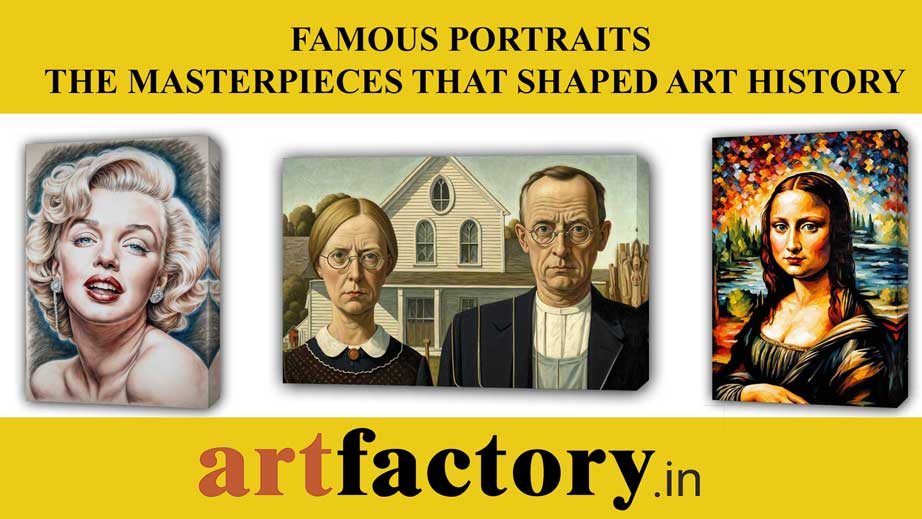
Famous Portraits: Timeless Masterpieces That Shaped Art History
Portraits have long served as more than just reflections of appearance—they capture the essence of personality, status, and the spirit of their times. From the enigmatic smiles of iconic figures to powerful self-portraits, famous portraits have transcended generations, continuing to inspire, intrigue, and awe. Here, we’ll delve into some of the world’s most celebrated portraits, each a masterpiece that represents an enduring chapter in art history.
1. The Mona Lisa by Leonardo da Vinci
The "Mona Lisa" by Leonardo da Vinci is arguably the world’s most famous portrait. This captivating painting features a woman with a mysterious smile, drawing viewers into an intense connection that has transcended centuries. Known for da Vinci's masterful technique of sfumato, which blends lines and shadows seamlessly, the portrait has become a symbol of beauty and intrigue. Her gaze seems to follow the viewer, making the Mona Lisa an enduring enigma and a staple of Renaissance art.
2. Girl with a Pearl Earring by Johannes Vermeer
Often called the “Mona Lisa of the North,” Vermeer’s "Girl with a Pearl Earring" presents a young girl with an exotic look and an entrancing gaze. Vermeer’s meticulous technique captures light and shadow with an almost photorealistic quality. The subject’s innocence and allure are heightened by her distinctive clothing, the pearl earring, and Vermeer’s masterful portrayal of subtle expressions, making this painting a timeless example of Baroque art.
3. Portrait of Madame X by John Singer Sargent
John Singer Sargent's "Portrait of Madame X" is a portrayal of elegance, mystery, and controversy. The subject, Virginie Gautreau, is depicted in a striking pose and a daringly modern black dress. Sargent’s use of contrasts between light and dark tones highlights her beauty and confidence. The portrait’s initial public reception was scandalous, yet it has since gained acclaim as a masterpiece of high society portraiture, capturing the allure of late 19th-century Parisian fashion and sophistication.
4. Self-Portrait with Thorn Necklace and Hummingbird by Frida Kahlo
Frida Kahlo’s "Self-Portrait with Thorn Necklace and Hummingbird" is a deeply personal piece, reflecting her inner struggles and resilience. Through symbolic elements like the thorn necklace and the hummingbird, Kahlo reveals both suffering and hope. Her use of vibrant colors and surrealist elements creates an unforgettable visual narrative, making her self-portraits some of the most iconic expressions of 20th-century art.
5. The Arnolfini Portrait by Jan van Eyck
Jan van Eyck’s "Arnolfini Portrait" is a remarkable composition that combines realism with rich symbolism. Depicting a wealthy couple in their home, the portrait is thought to be a representation of marriage or betrothal. Van Eyck’s keen attention to detail—from the texture of fabrics to the reflections in the convex mirror—makes this a masterpiece of the Northern Renaissance and a complex portrayal of love, status, and prosperity.
6. American Gothic by Grant Wood
"American Gothic" by Grant Wood is a portrait that captures the essence of rural American resilience during the Great Depression. Featuring a stern farmer and his daughter standing in front of a Gothic-style farmhouse, this portrait has become an iconic image of American culture. Wood’s detailed, realistic style highlights the subjects' strong features, capturing the simplicity and strength of the American spirit in the 1930s.
7. Whistler’s Mother by James McNeill Whistler
James McNeill Whistler’s "Whistler’s Mother," formally known as "Arrangement in Grey and Black No.1," portrays a moment of serene dignity. The minimalist color scheme and the quiet grace of Whistler’s mother emphasize simplicity and balance, while also capturing the personal nature of family bonds. This portrait has become an iconic representation of motherhood and restraint, making it one of the most celebrated American artworks.
8. The Blue Boy by Thomas Gainsborough
Thomas Gainsborough’s "The Blue Boy" is a portrait that captures the elegance of British nobility in the 18th century. Known for its rich, deep blues, this painting showcases Gainsborough’s skill in color blending and texture. The boy’s refined posture, clothing, and demeanor embody the opulence of the period, with Gainsborough’s background in landscape painting adding a unique depth to the composition.
9. Marilyn Diptych by Andy Warhol
Andy Warhol’s "Marilyn Diptych" is a landmark of Pop Art, celebrating Marilyn Monroe’s celebrity status while exploring themes of fame and mortality. Created through a repetitive, silkscreen technique, Warhol printed Monroe’s image in vibrant colors and grayscale, symbolizing the contrast between her glamorous public persona and the darker reality of her life. This portrait has become an emblem of both Monroe’s legacy and the impact of media culture, making it an iconic piece of modern art.
The Legacy of Famous Portraits
From Renaissance elegance to modern pop culture, these famous portraits demonstrate the evolution of art and its ability to immortalize individuals, styles, and social commentary. Each of these masterpieces offers a unique insight into its era, telling stories of beauty, power, struggle, and identity that continue to resonate across generations. Whether through classic techniques or bold experimentation, these portraits are lasting reminders of art’s power to connect us with the human experience.
These famous portraits are more than just paintings; they’re visual legacies that capture the essence of humanity across time. They remain as captivating today as they were centuries ago, each one a masterpiece that continues to influence art, culture, and our understanding of self.

Comments : (0)